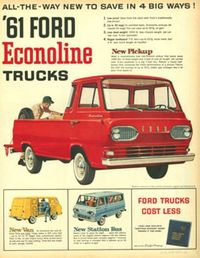Key Milestones in 50-Year History of Ford E-Series, America's Favorite Full-Size Van for 31 Years
SEE ALSO: Ford Buyers Guide-Compare 15 Years of Ford Econoline/a>
SEE ALSO: E-Carmony: Will the 2011 Ford E-Series Van Match Your Needs?
DEARBORN, Mich., Sept. 13, 2010; Since 1961, the time-tested Ford E-Series has been there for customers and businesses, providing smart innovations and the right equipment to get the job done. As times and the needs of customers changed, the E-Series evolved to meet them.
Here, a few highlights from E-Series' storied history:
Econoline is introduced for commercial customers with three
1961: bodystyles: Delivery Van, Pickup and Station Bus
Club Wagon introduced as passenger and load-carrying vehicle
1962: with light towing capabilities
1963: Seat belts introduced as an option
1965: SuperVan (extended, bustle-back model) introduced midyear
Second-generation Econoline vans available in three series: E-
100, E-200 and E-300 (air conditioning offered for the first
1968: time)
1971: Econoline Parcel Delivery Van added to lineup
Third-generation Econoline debuts with body-on-frame
construction, higher gross vehicle weight ratings, improved
interior package and wider selection of engines. This design
was offered in the same basic configuration for the next 17
1975: years
Factory-customized, youth-oriented Cruising Van debuts with
1976: mod paint schemes, carpeted interior and porthole panel windows
1978: Econoline chassis cab model debuts
1981: Higher payloads appear on most models
1983: Super Wagon reintroduced to lineup
1987: E-250 eight-passenger Club Wagon added
Fourth-generation introduced - Van and Club Wagon; Chateau
1992: Wagon is MOTOR TREND Truck of the Year
Econoline attained leadership in virtually every aspect of the
full-size van market with 48 percent share of its segment, 33
percent of the van conversion market, 90 percent of the Class C
motor home conversion market, 40 percent of the parcel delivery
van market (Econoline chassis), 90 percent of the ambulance
market (Econoline commercial cutaway chassis) and 39 percent of
1995: the passenger van market (Club Wagon)
1997: New standard V6 engine offered along with the 6.8-liter V10
E-Series name debuts in Ford literature, along with the E-150
2001: Traveler van targeted for families
Powertrain options now include V8, 6.0-liter Power Stroke V-8
2005: turbo diesel and V10
2006: Last E-Series model produced at Lorain Assembly Plant in Ohio
First E-Series model produced at Ohio Assembly Plant in Avon
2007: Lake
E-Series debuts as strictly a commercial vehicle; features
best-in-class capability, an improved chassis for better
durability and handling, cargo security technologies and the
2008: return of the diesel engine option
E-Series, America's best-selling van for 31 years, celebrates
its 50th anniversary by offering premium Ford-exclusive
technology like SYNC(R) voice-activated communications and
entertainment system and industry-exclusive Ford Work
Solutions(TM). E-Series vans are available in E-150, E-250
Super Duty and E-350 Super Duty regular and extended-length
configurations. Wagons are available in E-150 and E-350 Super
Duty regular and E-350 Super Duty extended-length
2011: configurations
About Ford Motor Company
Ford Motor Company , a global automotive industry leader based in Dearborn, Mich., manufactures or distributes automobiles across six continents. With about 159,000 employees and about 70 plants worldwide, the company's automotive brands include Ford, Lincoln and Mercury, production of which has been announced by the company to be ending in the fourth quarter of 2010. The company provides financial services through Ford Motor Credit Company. For more information regarding Ford's products, please visit www.ford.com.



